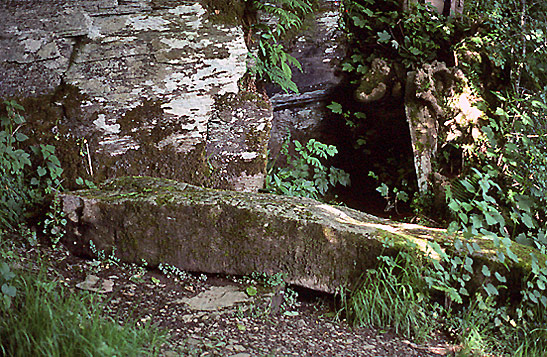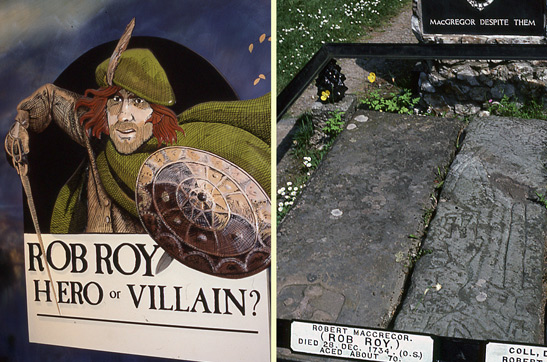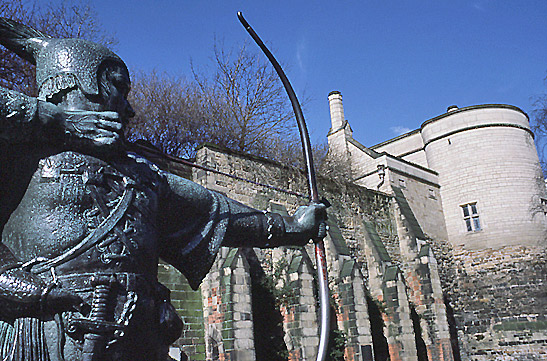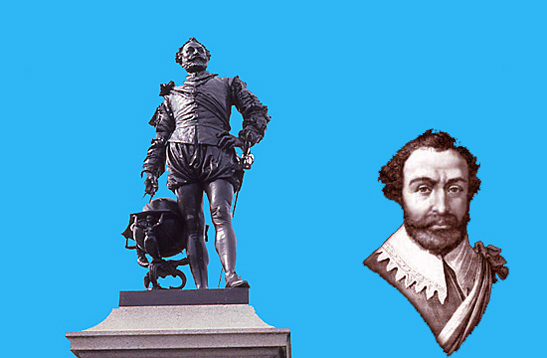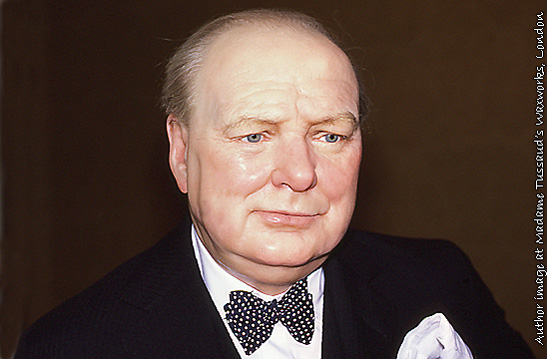 |
 |
|
 |

|
In Search of Heroes: Britain
By Nancy & Eric Anderson Photography by Authors
Some heroes are easy to find: The names of Joan of Arc and Nathan Hale, for example, span the world. Then there are others -- persons who parade through a past so amorphous it could take a lifetime to locate concrete evidence of their achievements. American tourists who do not have a lifetime but only a vacation better start in Britain where people speak their language. The visitors will be asking lots of questions. Each British county has its legends. The lives of some heroes are well-documented, but facts about others have been lost in time. And now we are lost in time, standing in William Blake's Britain, walking on "England's mountains green." The view is seaward to where a towering bluff thrusts into a foaming ocean. This is King Arthur's country, and his very presence surrounds us here in Cornwall, a part of West England quaintly removed from present-day Britain by its geographical remoteness and its local superstitions. Tourists often confuse King Alfred -- an English ruler who died about AD900 and whose reign is quite authenticated -- with Arthur, a folk hero who probably lived about the sixth century, but was glamorized by later poets and writers. Much of the Arthurian legend, handed down for centuries, is unsubstantiated. Nevertheless, it is the stuff that makes the blood tingle, especially that of two pilgrims standing on a 700-foot cliff at Tintagel Head, braced against a stiff sea breeze and looking down on the boiling Atlantic below, the savage rocks and the remains of what might have been King Arthur's castle. It was logical to build a castle at this virtually inaccessible site. The fury of the sea made attack from that quarter impossible. Indeed, the peninsula on which the fortress stands today is about to become an island. The cliffs which used to support the great drawbridge already have disappeared -- torn away, literally, by time and tide. Tintagel Head now lies at the water's edge, like a huge aircraft carrier putting out to sea. One day it will indeed sail away, carrying the remnants of one of England's most fascinating and controversial castles into eternity. Confusion, not Arthur, reigns here today. There's no doubt the castle exists, but it probably was built by Reginald, Earl of Cornwall, in the middle of the 12th century. Arthur lived six centuries before; indeed mention of him first appears in print in the Historia Britonum, compiled about AD685. A few miles inland, the river Camel winds peacefully past the little village of Camelford, which the poet Lord Tennyson called Camelot. One mile north of town is a spot unknown to tourists that may be more authentic than any part of the Arthurian story. The road over the river takes a sharp cant and here in AD542 Arthur's armies defeated the forces of his nephew Modred, who was killed in the battle. Here, historians tell us, 60,000 gathered, "sparks flew out, spears shattered, shields broke, shafts snapped ... the Camel was in flood with measureless blood." Here, too, in Slaughterbridge, it is believed Arthur was mortally wounded and, some say, laid to rest.
And here is the very essence of the search for heroes: One hundred yards above the bridge, amongst a tangle of green ferns and stinging nettles, lies a great granite stone the size and shape of a coffin, backed into the river bank as if it were a mausoleum. Forget the local belief that this is the tombstone of a Celtic chief killed in battle AD825. Forget popular opinion that Arthur is buried in Glastonbury. Forget the common conviction that Arthur never really lived, much less died. Instead, remember the spot where the river runs silently,
as if in reverence. Nothing else moves, except a few dragonflies darting
amongst the sweet-smelling mint that grows on the bank. In the intense,
deep shade, day seems night and time stands still in Camelot. Let us leave Arthur there, where the river Camel whispers by as if telling the world about the exploits that rocked England. To the north, in central Scotland, lies another grave - this one better detailed -- of a man as colorful as a Cornwall king but of a later century -- Rob Roy MacGregor. While scholars ask, "Did King Arthur really live?" and agree that if he did, his exploits were glorious, they know for a fact that Rob Roy MacGregor was a real person who died at an old age in 1734. What they don't know is whether he was a man of adventure or simply a scoundrel. The answer does not lie in his modest resting place at the Braes of Balquidder, amongst the heather-clad hills of Perthshire. In that place, there is only peace and serenity. The land slopes down to the lake beyond the small parish church; Highland cattle, goats and horses feed on the lush grass. Occasionally, the animals glance up as they graze, catching sight of a rabbit scampering amongst the buttercups or a field mouse hiding from a sparrow hawk soaring in the updraft near the tops of the cliffs. Or they gaze at strange humans who wander amongst the tombstones and finally say, "Here it is. Here's the grave." MacGregor lies in the shadow of a ruined church, a heavy granite block protecting his remains, family members beside him. It's all as peaceful as his death in an armchair by the fireside -- a surprisingly uneventful end to so wild a life. MacGregor was a cattle dealer from the northern part of the Highlands. Life was bleak, the land barren and the weather miserable. This gave the Highlanders a common cause -- they stuck together to survive and, regarding the Lowland Scot as inferior, they often saw him as a means of survival.
MacGregor was a resourceful man with a reputation for occasionally making off with Lowland cattle. He attracted the attention of a powerful landowner, the Duke of Montrose, who saw in MacGregor's skills a chance to increase his own considerable wealth. Montrose put up the money for MacGregor to buy cattle, securing the loan with MacGregor's house and land. But when his drover absconded with the money, MacGregor was left with unpayable debts. Montrose seized his partner's property and declared him an outlaw; MacGregor was on the run for the rest of his life. He retaliated by raiding Montrose's property every chance he had. He became a colorful local character, then a national hero -- Scotland's last rebel against authority. His exploits were sounded all over the country. He would hold up Montrose's rental agents as they collected from tenants, then force the wretches to write receipts for the tenants. He would slip money to poor farmers about to be evicted by Montrose's men for non-payment of rent, then rob the estate agents as they left the cottages. Several times he was captured, but he always managed to escape by his own resources or the kindness of sympathizers A statue honoring MarGregor stands near Stirling Castle. Both it and the grave site are easily accessible from any of the small towns along the river Earn. Today, the East Midlands of England are hardly the place to look for romantic heroes: This is industrial England with a vengeance. Nottingham is a fairly hard 140-mile drive up the motorways from Heathrow Airport, yet there's much to see and admire in what 700 years ago was one of England's largest wooded tracts, Sherwood Forest. Nottingham tries hard to get on with business and ignore its past: Those hand-painted Gothic letters on the whitewashed wall may proclaim "The Oldest Inn in England," but two streets away, the corner grocery flaunts a fluorescent sign that screams "Cheapest Booze in Town." Nottingham, of course, is known not so much for the price of its alcohol as for the cost to its onetime sheriff of trying to suppress a legend that still lives today: The story of Robin Hood.
His bronze statue faces the castle. His bow is drawn symbolically at the gatehouse. The arrow waits the statue's bidding. "Actually, the statue's lost its arrow more than 50 times," says a guide, instantly breaking the spell. "Tourists, drunks, schoolboys and vandals have helped themselves over the years -- it's said if you could break down a few doors in town you'd sure find dozens of those arrows." Did Robin Hood live? If so, who was he? Are the stories true? Who can tell? Some say Robin Hood came from the aristocracy and was really the Earl of Huntington; some claim he came from yeoman stock. Some say he was born in Locksley in AD1160 and lived 87 years. And some say there is a grave where a man named Robin Hood was buried in AD.. 1247 at Kirklees Priory, in the Calder valley near Huddersfield, Yorkshire, a long march to the north. So they say. Rob Roy and Robin Hood were called many things but never "patriots." Our last two heroes were surely that although they lived and died more than three and a half centuries apart. The statue of Sir Francis Drake stands high on Plymouth Hoe on the coast of Southern England. The harbor is much visited by Americans because the Pilgrim Fathers sailed from it in September 1620 in their 180-ton Mayflower. But the date that put Sir Francis Drake into both battle and English legends was earlier, namely July 1588: The signal fires flared along the coast as the long-expected Spanish Armada was sighted in the English Channel. The Spanish fleet was the most massive in naval history. Drake was playing in a game of bowl atop the cliff in Plymouth. His opponents drew his attention to the bonfires announcing the onset of war and Drake famously gave the reply that has emblazoned him in British history textbooks: "There is plenty of time to win this game and to thrash the Spaniards too."
The English had better ships and better leadership. They also had the notorious British weather on their side and a confused enemy who sheltered for the night in Northern France. As the gale raged the English sent fireships downwind. They broke up the Spanish fleet. The fury of the storm sent the Spanish Armada into the North Sea and around the north of Scotland where many ships sank. The Armada put another historical comment into history too, that of the English Queen Elizabeth I whose Speech to give heart to her troops at London docks on the approach of the Armada included: "I know I have the body of a weak and feeble woman, but I have the heart and stomach of a king, and of a king of England too." "The weak and feeble woman" had just ordered the beheading of her cousin the year before. She at the moment is the 6th longest-reigning British monarch although her namesake, Elizabeth II, is now the 3rd longest. Drake had a checkered career. In 1577 he was the second man in history to circumnavigate the globe (after Magellan) and as a privateer with his Queen's blessing he became the scourge of the Spanish silver trade galleons - and a wealthy man. Drake, however, failed to destroy the remnants of the Armada and ultimately died in his monarch's disfavor. The history of the statue reflects this. The public donated only £513 in 1881 for the statue and what finally went up was a replica of another raised by the wealthy Duke of Bedford in the nearby town of Tavistock. The world is not necessarily kind to heroes.
Winston Churchill found that out, too. The pugnacious man who defied Hitler in World War II at a time when Britain stood alone against the strength of Germany was in a way Britain's secret weapon. His oratory skills not only encouraged his nation but F.D. Roosevelt himself. Churchill's first speech as British Prime minister reiterated that of Teddy Roosevelt that he had nothing to offer but "blood, toil, tears and sweat." And as France surrendered and Britain prepared for a German invasion in 1940 his voice rang out over the radio to the world: "We shall fight in France, we shall fight on the seas and oceans, we shall fight with growing confidence and growing strength in the air, we shall defend our island, whatever the cost may be, we shall fight on the beaches, we shall fight on the landing grounds, we shall fight in the fields and in the streets, we shall fight in the hills -- we shall never surrender." Albeit, the statues of him across Britain show his bulldog
strength and his passion for his country. He is perhaps Britain's last
real hero. |
|
In the meantime, here are some of the feedback we have already received:
|
![]()
Stay tuned.
This site is designed and maintained by WYNK Marketing. Send all technical issues to: support@wynkmarketing.com

|











